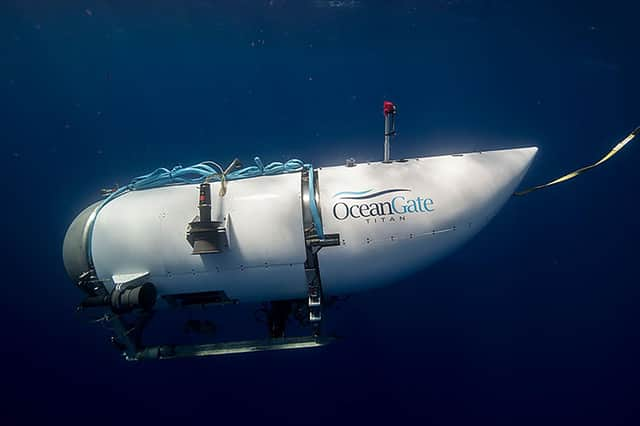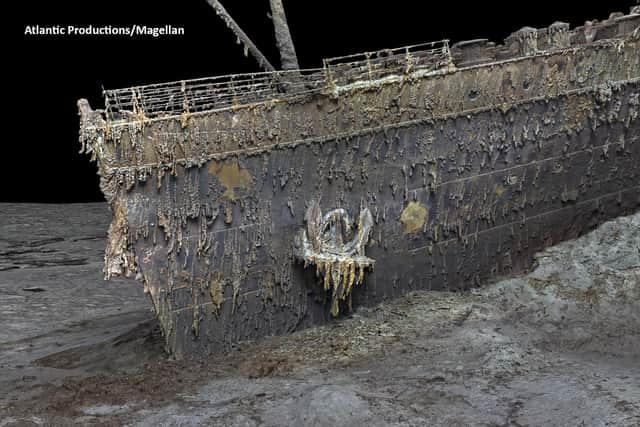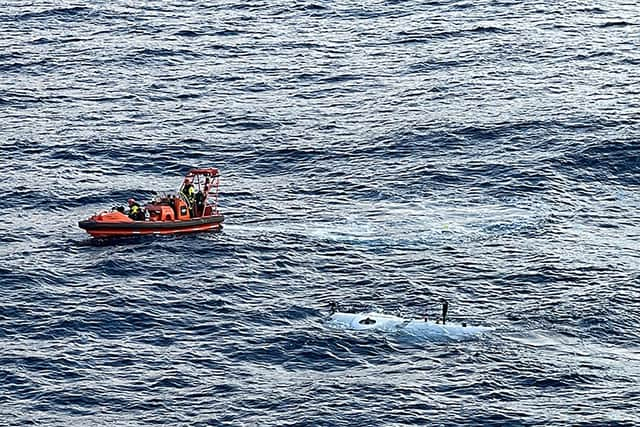Titan Submersible: What went wrong, what do experts think and was it doomed to follow in Titanic's wake?


After the Titan submersible lost communication on Sunday June 18, it was clear to many experts within the field that there would be little chance of a happy ending.
Shortly after the vessel lost contact on Sunday June 18, the US Navy detected sounds which were “consistent with an implosion”.
Advertisement
Hide AdAdvertisement
Hide AdWith the five people on board now confirmed to have died, questions surrounding the safety of submersibles are being raised.
But what do we know about what happened so far, and what are experts from across the industry saying?
What happened with the Titan submersible?
After losing communication with the surface on Sunday, officials began a massive search operation to find the Titan vessel shortly after.
The four day search came to a sad conclusion on Thursday when the Coast Guard discovered “five different major pieces of debris” from the Titan.
It followed intensive searches, warnings from the Coast Guard about falling oxygen levels and false hope in the form of underwater sounds.
It emerged that following the initial loss of contact on Sunday, the US Navy had picked up sounds “consistent with an implosion”.
The vessel was constructed from carbon fibre and titanium. If any cracks or faults developed while descending, the pressure would become overwhelming and cause an instantaneous implosion.
There is no possible way that any of the five people on board could have survived.
Advertisement
Hide AdAdvertisement
Hide AdWas the Titan submersible safe?
Since the vessel went missing, questions have been raised about the safety on board.
A CBS journalist, David Pogue, last year joined one of OceanGate’s excursions. He reported that beforehand he had to sign a waiver which described the vessel as "experimental" and that it had "not been approved or certified by any regulatory body, and could result in physical injury, disability, emotional trauma or death".
During his exploration in the Titan, communication failed with the sub lost on the ocean floor for two and a half hours before it was hoisted up and out of the water.
Those inside the vessel must be bolted in from the outside and each trip would start with 96 hours of life support. The five individuals within the vessel must sit in a small and narrow cylinder for a mission which can often last 12 hours.
The sub was piloted using a modified but still recognisable Logitech brand games controller, but while this may raise eyebrows it is actually fairly common. The US Military often use Xbox controllers to control equipment including tanks and submarines.


Insight from experts within the submersible industry had previously raised their concerns over OceanGate’s submersible in 2018.
William Kohnen the president and CEO of Hydrospace Group, a company which provides expert knowledge of underwater vehicle systems and pressure vessels, expressed his fears that Titan’s design and construction was not being tested by a third party.
Mr Kohnen wished for OceanGate, whose CEO Stockton Rush was a passenger on the Titan, to adhere to industry standards, to take responsibility and follow industry standards where Mr Rush claimed regulators were stifling innovation.
Advertisement
Hide AdAdvertisement
Hide AdIn an earlier interview with Mr Pogue, Mr Rush said: “I don't think it's very dangerous. If you look at submersible activity over the last three decades, there hasn't even been a major injury, let alone a fatality.
“What worries us is not once you're underwater. What worries me is when I'm getting you there, when you're on the ship in icy states with big doors that can crush your hands and people who may not have the best balance who fall down, bang their head. That's, to me, the dangerous part. But, the scary part for most people is going down to 6,000 PSI.”
While speaking to Sky News, Mr Kohnen expanded upon fears about the Titan submersible.
"Nobody has made a five-person submersible going 4,000m. Most of the submarines – there's 10 submarines that will go 4,000m or deeper in the world – they are all certified and they tend to be three-people vessels with one pilot and two occupants for research.”
He wasn’t alone in his fears with court documents emerging which revealed that OceanGate fired David Lochridge, then the director of marine operations, who raised safety concerns in 2018.
Before the Titan’s implosion, there were serious safety concerns raised. So, was OceanGate doomed to repeat history?
Has OceanGate failed to learn from history?
For all that OceanGate promoted its dives as a partly scientific fact finding mission, it has been suggested by some – Mr Cameron among them – that there is irony in the Titan’s tragic fate.
The Titanic was the “unsinkable” ship, yet on its maiden voyage it struck an iceberg and sank.
Advertisement
Hide AdAdvertisement
Hide AdPart of the reason it was thought to be “unsinkable” was due to the state-of-the-art safety design. The Titanic had 16 compartments with doors which could be closed from the bridge to contain water in case the hull was breached. It was claimed that four compartments could be flooded without the ship’s buoyancy being compromised.
That wasn’t the case. The day the Titanic sank, its Captain cancelled a scheduled lifeboat drill. Just before 6pm he would receive several iceberg warnings and slightly alter the course of the vessel but not lower its speed.


Further warnings went ignored by the wireless operator and the calm weather conditions made the iceberg near impossible to see. It wouldn’t be until a lookout raised the alarm at 11pm that efforts to redirect the ship were made. Around 1,500 of the ship’s 2,200 passengers survived.
James Cameron has echoed much of what Mr Kohnen stated. The Titanic director has a strong understanding of the engineering issues which come with submersibles, having designed a sub and completed 33 dives to the wreck of the vessel.
Mr Cameron has also drawn comparisons between OceanGate’s Titan disaster, and its mission the Titanic.
Speaking to ABC News in America, he said: “I’m struck by the similarity of the Titanic disaster itself.
“The captain was repeatedly warned about ice ahead of his ship, and yet he steamed full speed ahead into an ice field on a moonless night. Warnings went unheeded. For this to take place at the same exact site, it’s quite astonishing.”


Calling deep sea submersibles a “mature art”, Mr Cameron stated that the Titan was another wreck “based unfortunately on the same principles of not heeding warnings”.
Advertisement
Hide AdAdvertisement
Hide AdThe Marine Technology Society committee’s letter to Mr Rush in 2018 stated: “Our apprehension is that the current experimental approach adopted by Oceangate could result in negative outcomes (from minor to catastrophic) that would have serious consequences for everyone in the industry.”
It went on to call for minimum standards of safety and testing to be met, but unfortunately regulating deep sea submersibles is difficult as they mainly operate in international waters, which are free from any one nation’s regulations.
Why did the implosion happen?
At this stage, pinpointing a specific reason the Titan imploded will be difficult. However, there are several factors which can be considered.
Writing for The Conversation Eric Fusil, an associate professor at the University of Adelaide’s School of Electrical and Mechanical Engineering, gives some insight into the vessel's failure.
Most submersibles which operate at the depths the Titan did will be spherical and made of titanium or a thick steel. They must withstand the pressure you experience at those depths which makes the Titan so unusual in comparison.


Built with titanium and carbon fibre, Mr Fusil states that these materials used together are “unusual”. Titanium has a more elastic quality to it which means it can withstand extended stresses and bounce back from them without permanent strain, whereas a carbon-fibre composite doesn’t have the same elasticity and is more rigid.
Speculating, Mr Fusil also believes that there would almost certainly be a loss of integrity between the two materials.
Any minor defect becomes catastrophic when dealing with underwater pressure, and would trigger an instantaneous implosion which would force the Titan to crumple from all sides. Those on board would be dead within 20 milliseconds, with the human brain unable to process information at such speeds.
Advertisement
Hide AdAdvertisement
Hide AdIt is still too early to understand exactly what happened to OceanGate’s Titan submersible, but there are many factors which could have contributed to this tragedy and many lessons which will be learned.
What has OceanGate said about the incident?
On Thursday evening, OceanGate issued the following statement:
The BBC reports that in a blog post about it in 2019, the company said the way that Titan had been designed fell outside the accepted system - but it "does not mean that OceanGate does not meet standards where they apply".
Comments
Want to join the conversation? Please or to comment on this article.
